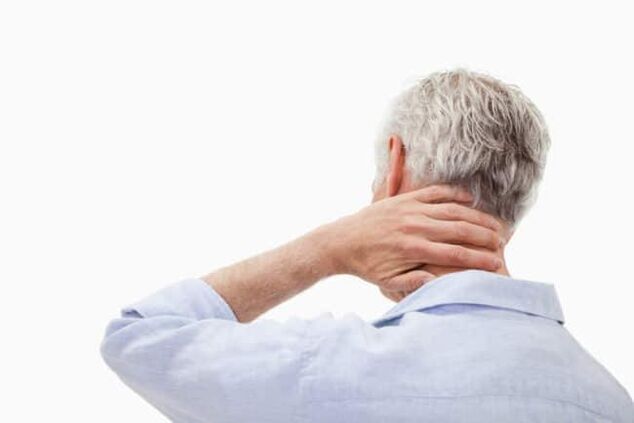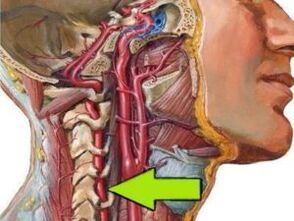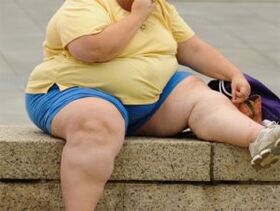Among all pathological processes affecting the spine in different parts, cervical osteochondrosis is considered the most common and painful.This disease mainly causes too much complications because it affects the spinal cord and also adversely affects the functioning of the brain.

What is cervical osteochondrosis?
In medical practice, the words of cervical osteochondrosis mean a acquired progressive disease affecting the specific spine.This pathological procedure is characterized by degenerative-distrophic processes in the tissues of the intervertebral discs, which are shocked for cervical vertebrae.Degenerative-Distrophic changes in intervertebral discs are due to their deleted and deformed.As a result, the distance between the vertebrae decreases and as a result, the following results arise:
- Narrowing of the spine canal in certain parts of the spine.
- Passing through the vertebral arteries - large blood vessels that provide blood flow to the brain.Because the brain supply deteriorates and blood circulation is impaired in the cervical spinal cord.
- Intervertebral discs can be deformed and flattened.This leads to the squeezing of the individual sections of the spinal cord and nerves, more often, nerve roots are squeezed.
All these problems not only violate the blood circulation of the brain, but also painful feelings, headaches, etc.Osteochondrosis of the cervical region is dangerous by the problems of neurological nature, worsening of the central nervous system, damaging the brain tissue.According to the international classification, the osteochondrosis of the cervical region was appointed several separate code.The disease code for ICB 10 depends on the age of the disease: diagnosed with the disease:

- M02 - dystrophy of intervertebral discs in puberty.
- M42.12 is a dystrophic process in adults.
Many factors depend on the age of the patient and the degree of development of the pathological process, for example, consequences, complications, symptoms, and of course treatment principles.
Reasons
Knowing the causes of the development of osteochondrosis of the cervical region may play a decisive role in the diagnostic process and determine the principles of combating disease.However, before listing the causes, it is worth to say that doctors distinguished two factors that lead to the development of this pathological process:
- Pathological - Intervertebral discs and other vertebrates, nearby tissues, blood vessels and nerve beams under the influence of negative external factors to eliminate the pathological process.The more difficult these factors and other pathologies are, the faster the disease develops.
- Physiological - Based on the development of pathology, mostly changes in age.Spinal cord, salts and so on.
If we list more specific causes of cervical osteochondrosis, these are as follows:
- Violation of metabolic processes in the body and certain stages of obesity.
- Hipodynamia is a phenomenon characterized by mobility limitation.Not only about injuries or diseases, but also a still lifestyle and seating.
- The pathologies of the cardiovascular system contribute to the deterioration of blood circulation in the brain, pressure changes and other things.
- The wrong posture, these are various scoliosis, rheumatism and even flat foot forms.
- Injection of the cervical spine.In this case, we talk about sprains, strikes and bruises.In the development of cervical osteochondrosis, the investigation of the other spine may affect the development of cervical osteochondrosis.
- Depending on human activity, extremely large physical effort in the cervical area caused by intense sports or severe physical necessity.
- A non -searched lifestyle is dangerous with a fixed tension of the cervical spine and the entire spine if you sit in wrong or disturbing furniture.
- Hernia of cervical spine and various related diseases.
- The head must be kept long -term in a disturbing or unnatural position.In this case, not only the muscle is not tense, but also in the spine cervical region.
- Doctors constantly see stress and nerve excessive voltage as a very common reason.
- One of the reasons is also considered as congenital anomalies in the structure of the spine.

What is the danger for health?
As mentioned earlier, the cervical spine contains not only the spinal cord and various nerve branches, but also the oxipital part of the brain, cerebellum and medullavic brain.With the development of cervical osteochondrosis, nearby tissues are inflamed.In addition, the development of pathology threatens to squeeze nerve roots and transmit blood vessels, the results are as follows:
- Osteocondrosis is accompanied by deformations of the spine, resulting in this narrowing of the brain spinal cord in certain regions.This can lead to the squeezing spinal cord and nerve branches promising serious neurological problems.In severe cases, one person feels pain, even the possibility of loss of control over the individual parts of the body (essentially hand or face).
- As mentioned earlier, boredom of the neck is accompanied by a violation of blood circulation in the oxipital region of the brain.At the same time, the brain stops taking the necessary amounts oxygen and nutrients, and oxygen hunger begins.There is a real risk of stroke and various neurological pathologies with circulatory disorders.
Syndrome
Main syndromes:
- Vertebral.
- Vertebral artery.
- Koreshka.
- Cardiac.
It is important to know that each of these symptoms are accompanied by many negative clinical symptoms as well as painful sensations in different nature.A person may feel dizziness, a noise in his ears and much more.

Vertebral syndrome
It mentions the direct connection of osteochondrosis of the cervical region with bone and cartilage tissues.Symptoms in this type of pathology are also associated with the lesion of the tissues mentioned:
- Neck movements are partially or completely limited.
- The movement of the head is accompanied by pain in the neck.
- X -Ray shows morphological changes in tissues (in the body of intervertebral and vertebrae).
It should be noted that vertebral syndrome is always accompanied by these three clinical findings.If there is no at least 1, the diagnosis will be completely different.
Syndrome
The roots of the spinal cord occur when damaged.At the same time, nerve conductivity is impaired, a person may feel pain or lose the sensitivity of the individual parts of the body or even suffer from paralysis.8 These symptoms are distinguished, depending on which of the radicular is a conductivity disorder depending on which one of them:
- 1 pair - numbness or pain behind the head;
- 3 pairs - violation of chewing reflex, numbness of language and unpleasant feelings behind the ears;
- 4 pairs - Pain in the clavicle, a violation of swallowing reflex;
- 5 pairs - violations of the shoulder belt with the problem of hand movement;
- 6 pairs - the patient begins to feel pain and numbness in the forearm and shoulder blades;
- 7 pairs - hands and fingers are numb (usually knee and middle);
- 8 pairs - problems similar to the past item, but numbness on the ring finger and small finger are felt.
CARDIAL SYNDROME
Although the pathological process is still localized in the cervical spine, the syndrome has all symptoms of heart pathologies.Clinical picture is as follows:
- Fast pulse.
- Pain in the Sternum area.
- Shortness of breath, weakness, drowsiness, decrease in performance.
Symptoms and symptoms of cervical osteochondrosis
To search for a doctor, it is necessary to clearly understand the symptoms of cervical osteochondrosis.In some cases, such information allows you to get help in the early stages of the disease when it is easier to treat.In general, the osteochondrosis symptoms of the cervical spine are as follows:

- Pain is always available for osteochondrosis, only density and frequency are different.The first clinical sign is pain.Their density depends on the progression of the disease, they are stupid or stuck in nature.Painful sensations are mainly found in the oxipital area, but may spread to the temporal area, shoulder zone and hands.
- In most cases, the vestibular apparatus lesion has symptoms.We often talk about dizziness, nausea, corrupted coordination of movements, unequal walking, space loss.
- One of the most common clinical findings is the hardness of the neck muscles and the hardness of movements.A person is difficult to dizzy, lower and throw, movements respond to pain seizures.
- Many patients note the feeling that my goose bumps are “passing through the scalp” or a characteristic tingling felt.
- There is muscle weakness and numbness in the hands of the hands.
- Usually there are depression, drowsiness, a sharp change in mood, psychological symptoms expressed in anger or irritability.
- Due to damaged blood circulation and damage to the brain tissue, dizziness concentrates and noise in the ears such as rustling, vibration and bell.
- Most patients draw attention to the pain in the eye spheres, as well as visual impairment in the eye spheres, especially when trying to mow their eyes to the left, right, up, or below.
It is sometimes possible to determine the degree of development of the pathological process with symptoms.However, for a complete diagnosis of this, this is still not sufficient and a number of diagnostic measures are required.
Diagnosis Methods
The diagnosis of osteochondrosis of the cervical spine is required to determine the localization and stage of the disease.For full diagnosis, such diagnostic methods are needed:
- X -Ray - The primary method that allows you to determine the degree and localization of the deformation of the spinal column.
- You can use computerized tomography for a more accurate diagnosis of pathological changes in the vertebrae and intervertebral discs.
- MRI (magnetoresonance imaging) - it makes it possible to examine the wheels and vertebrae in detail, to determine the presence of hernias, the scale of the protrusions and the rest of the lesions of the rest.
- Doplerography - also becomes the opportunity to find a place to examine, to squeeze artery, to evaluate the degree of circulatory disorders.
Treatment Methods
The treatment of neck osteochondrosis always means an integrated approach.Treatment principles, the age of the patient, the development of the disease, the brightness of clinical painting, etc.It depends on the mass of factors such as.However, in this case you cannot do it without a doctor, and you can first consult in a therapy that will direct you to the vertebologist.As for the integrated approach: Osteochondrosis of cervical osteochondrosis is treated using other methods that need to be discussed in more detail.
Drug therapy
The basis of the treatment of cervical osteochondrosis is the medication that includes the use of tablets, drugs and drugs of such groups:
- Anesthetic - analgesics and antispasmodics.First, the boring nerve centers directly stop painful sensations.Secondly, it allows you to alleviate the spasm of the neck muscles, create a blood flow and suppress the pain.
- NSAIDS -Unflauding -Canal anti -inflammatory drugs are required to reduce the inflammatory process, most of them eliminate pain.Generally, these drugs are used as gels, ointments applied to the affected area.
- Musorelaxans are another way to remove muscle spasm in the cervical region.
- Condroprotectors are mandatory at certain stages of pyrzola osteochondrosis because they contribute to the restoration of bone tissues.
- B vitamins - normalize the metabolic processes of nerve tissues, increase the conductivity of nerve impulses and contribute to the work of the central nervous system.
Remember, treatment should only be done under the supervision of a doctor responsible for the appointment of each drug, and the purchase and dosage time must be determined.
Physiotherapy
Treatment of neck osteochondrosis will be more effective by using some physiotherapy techniques:

- Electrophoresis.
- Laser treatment.
- Ultrasound.
- Massage.
Massage therapy is absolutely performed by an experienced health worker, treatment is performed with at least 10 sessions.Massages of the cervical region, normalizing blood circulation, flexibility, muscle tone recovery, alleviating pain and so on.
Manual therapy
Manual therapy is based on the principle of restoring motor functions and recovery of mobility between the vertebrae.Initially, manipulations are in a slightly relaxing massage, then the doctor increases more and more power, the pressure and turns of the neck affect the vertebrae.
The use of Kuznetsov applicators is one of the treatment methods for spine diseases, including osteochondrosis.The effect of adaptation on the cervical region normalizes metabolic processes, alleviates pain, increases muscle tone, increases blood circulation, increases the conductivity of nerve tissue, etc.To prevent osteochondrosis, it is useful to hang a swimming and horizontal bar for 2-3 minutes every day.


























































































